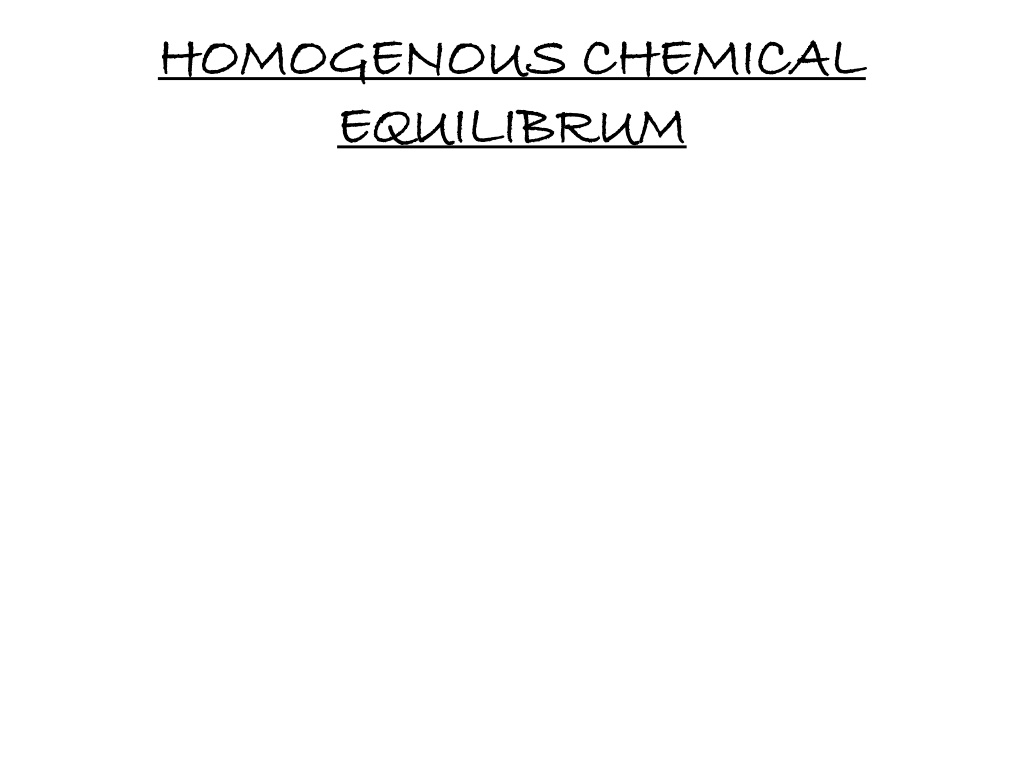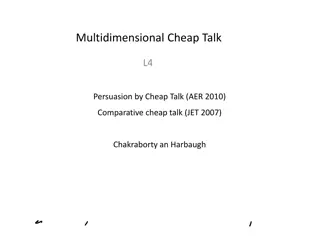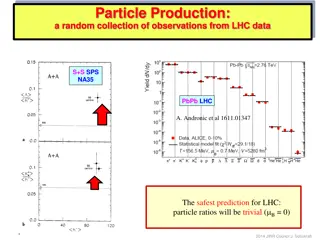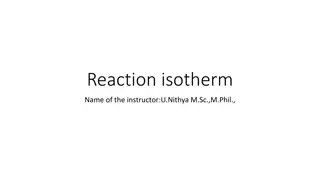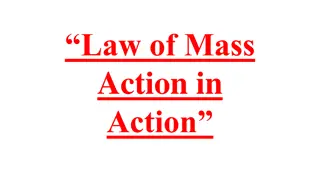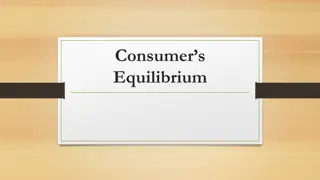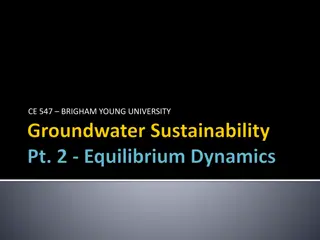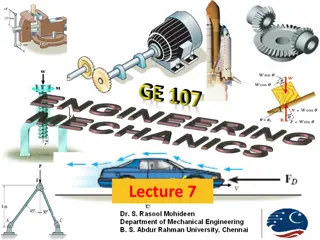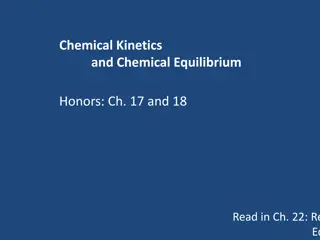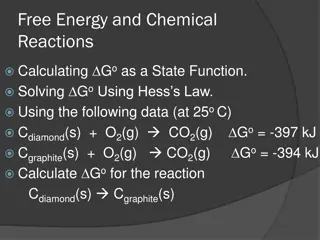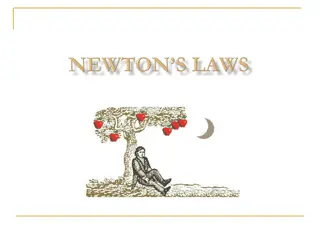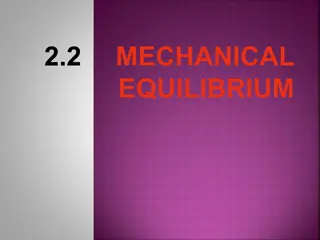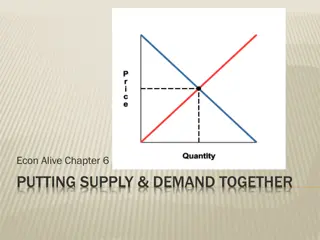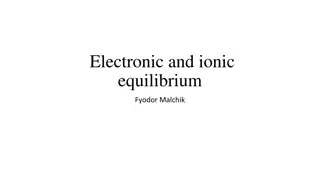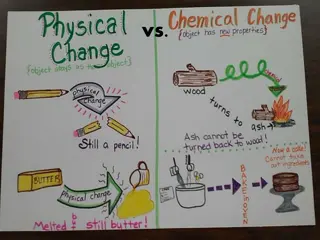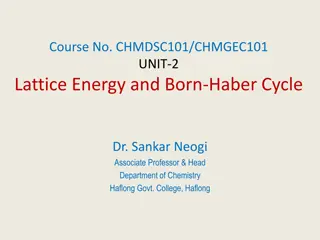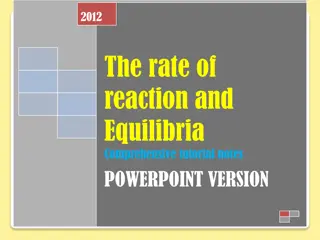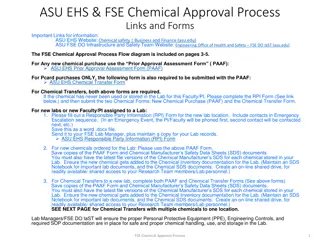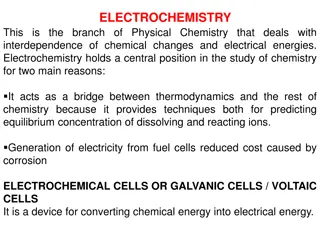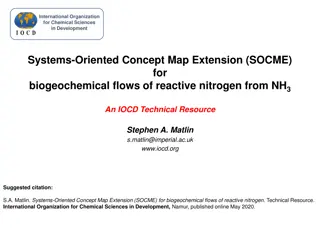Understanding Homogenous Chemical Equilibrium
Homogenous chemical equilibrium occurs when reactants and products are in the same phase. This equilibrium remains independent of the volume of the reaction mixture. The concept is illustrated through the example of the Hydrogen-Iodide system and a generic reaction A + B --> 2C. Partial pressure plays a crucial role in understanding this equilibrium state.
Download Presentation

Please find below an Image/Link to download the presentation.
The content on the website is provided AS IS for your information and personal use only. It may not be sold, licensed, or shared on other websites without obtaining consent from the author. Download presentation by click this link. If you encounter any issues during the download, it is possible that the publisher has removed the file from their server.
E N D
Presentation Transcript
HOMOGENOUS CHEMICAL HOMOGENOUS CHEMICAL EQUILIBRUM EQUILIBRUM
Homogenous equilibrium is an Homogenous equilibrium is an equilibrium in which the reactants equilibrium in which the reactants and the products are in the same and the products are in the same phase. phase.
- -Homogenous gaseous equilibria Homogenous gaseous equilibria
Case I: Case I: The Hydrogen The Hydrogen- -Iodide system Iodide system
Consider a reaction Consider a reaction
A +B A +B 2C 2C
e.g e.g + +
t=0 t=0 a a b b
t=t t=t a a- -x x b b- -x x 2x 2x
if V (in dm if V (in dm3 3) is the total volume of ) is the total volume of the reaction mixture the reaction mixture
then, then,
Hence, Hence, = =
is independent of the volume is independent of the volume
In term of partial pressure, In term of partial pressure,
But But , and , and
Where Where total number of moles, total number of moles,
total (external) pressures total (external) pressures are partial pressures of A, B and C respectively. pressures of A, B and C respectively. are partial
Examples: Examples:
of I of I2 2in a flask was heated until the in a flask was heated until the equilibrium is reached. On analysis, equilibrium is reached. On analysis, the equilibrium mixture is found to the equilibrium mixture is found to contain 0.7mole of HI. Calculate the contain 0.7mole of HI. Calculate the K Kc c
Consider this reaction Consider this reaction + +
following substances at 45 following substances at 45 0.065atm, =0.45 atm. and =0.245 0.065atm, =0.45 atm. and =0.245 atm. Calculate (a) the equilibrium atm. Calculate (a) the equilibrium constant K constant Kp pfor the reaction at 45 for the reaction at 45o oC C (b) the equilibrium constant K (b) the equilibrium constant Kp pfor the backward reaction the backward reaction for
K Kc cfor this reaction + for this reaction +
The K The Kp pfor this equilibrium reaction: for this equilibrium reaction:
is 0.11 at 25o oC, calculate Kc at C, calculate Kc at + + is 0.11 at 25 this temperature. this temperature.
The following results were obtained during analysis of a The following results were obtained during analysis of a reaction reaction + +
At 25o oC and 4 atm., is 10% dissociated, calculate the C and 4 atm., is 10% dissociated, calculate the Kp Kp for this reaction, for this reaction, At 25 + +
by 18.5%, calculate its K by 18.5%, calculate its Kp p temperature. If the atmospheric temperature. If the atmospheric temperature was reduced to half its temperature was reduced to half its original value at the same original value at the same temperature, calculate the degree of temperature, calculate the degree of dissociation of the gas. dissociation of the gas.
N N2 2O O4 4is 25% dissociated at 30 is 25% dissociated at 30o oC and 1 atm., calculate 1 atm., calculate C and
The equilibrium constant for the The equilibrium constant for the decomposition decomposition
The amount of NO The amount of NO2 2that would be attained if there had been 4 moles of attained if there had been 4 moles of N N2 2O O4 4at the same temperature and at the same temperature and pressure. pressure. that would be
N N2 2O O4 4is 25% dissociated at 37 is 25% dissociated at 370 0C and 1 atm., calculate 1 atm., calculate C and
The K The Kp pand (ii) the % dissociation at and (ii) the % dissociation at 0.1 atm and 37 0.1 atm and 37o oC C
having 0.28 having 0.28 atm. and 1.1 atm. pressures atm. and 1.1 atm. pressures respectively. If the volume of the respectively. If the volume of the container is doubled, calculate the container is doubled, calculate the new equilibrium pressure of the new equilibrium pressure of the gases. gases.
In an experiment, H In an experiment, H mole ratio 3:1 produced 0.0735mole mole ratio 3:1 produced 0.0735mole fraction of NH fraction of NH3 3at 350 at 350o oC and total pressure of 1013KNm pressure of 1013KNm- -2 2. Calculate Kp for the forward and reverse reactions for the forward and reverse reactions C and total . Calculate Kp
The K The Kp pfor this equilibrium reaction for this equilibrium reaction
2 (g) 2 (g) 1.45 x 10 1.45 x 10- -5 5at 500 partial pressure of NH partial pressure of NH3 3when the partial pressure of H partial pressure of H2 2is 0.928atm and that of N and that of N2 2is 0.432atm. 2 (g) 2 (g) at 500o oC. Calculate the C. Calculate the 3 (g) 3 (g) when the is 0.928atm is 0.432atm.
342mmHg at 840 342mmHg at 840o oC and at 860 the dissociation pressure is the dissociation pressure is 420mmHg. Calculate the heat of 420mmHg. Calculate the heat of dissociation of the carbonate. Given dissociation of the carbonate. Given that R=8.314KJmol that R=8.314KJmol- -1 1. . C and at 860o oC, C,
consider this reaction consider this reaction
N N2 (g) 2 (g) + 3H + 3H2 (g) 2NH 2NH3 (g) 3 (g), , 2 (g)
p p calculate (i) the G of the reaction calculate (i) the G of the reaction (ii) G when the partial pressure (ii) G when the partial pressure of N of N2 2, H , H2 2and NH and NH3 3are 10atm, 30 atm and 3 atm respectively. atm and 3 atm respectively. are 10atm, 30
